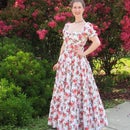Introduction: Hand Appliquéd Dress
I started my sewing journey many, many years ago with hand sewing. And, truth be told, I am most comfortable with the needle in hand rather than attached to a machine with a motor!
Eventually I got over my fear of getting injured by a sewing machine needle and started making my own clothing.
Over the years, I have added quite a few hand stitched touches to my clothing.
But it turns out, you can make a dress from start to finish entirely by hand!
Step 1: The Muslin
A few months back, I made a muslin of Vogue 9125 with the idea that it would work very well with a silk/wool blend fabric. The mock-up ended up more snug than I like in a woven, but it seemed that it might work in a stretch fabric.
Time for a change of plans!
Step 2: Dyeing the Fabric
I had just enough white cotton jersey stashed away for the dress, so it seemed like it was meant to be.
Then I had to decide on a color scheme - and this is what I came up with.
A sink full of fiber reactive dye later, and I had two different pretty pink fabrics ready to be cut.
Step 3: The Stencil
I made a stencil of this Alabama Chanin design a while back, but never actually got around to using it. Until now!
I have found that the most inexpensive way to create a stencil is using a heavy duty Pellon interfacing and an xacto blade to carefully cut the design out.
More details on that process may be found here.
Step 4: Hand Applique
The oversized stencil design made this a fairly quick project. At least, quicker than my previous hand appliquéd projects!
For this particular dress, I decided to use a double strand of embroidery floss to appliqué the two layers together.
It is not the strongest thread option out there, but the massive choice of color options makes the embroidery floss very tempting.
And since this dress really does not have much negative ease, I did not anticipate a problem with my thread choice.
Step 5: Constructing the Garment
I did use a button and carpet thread for the seams, just to be safe.
Each of the seams were stitched, right sides together with the heavy duty thread, then the seam allowance was folded to one side and top-stitched with the embroidery thread.
Some of those seam joins are rather thick with the multiple layers of fabric, so a pair of pliers is helpful to help pull the needle through.
Step 6: Finishing
I continue to love the raw edge neckline and hem on certain designs, but they often look rather sloppy after minimal wear!
I did, however, use a single fold to turn the neckline and hem, so those raw edges are on display from the inside of the garment. What a rebel, right! And I guarantee that this is just about as anti-seam binding as I am ever going to get . . .
A zipper was also added to the center back seam to make getting in and out of the garments easier, and making sure the running stitch appliqué would not snap.
And that is how to make a dress entirely by hand!




